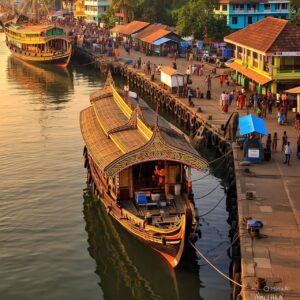
Kerala, the lush southwestern state of India, is globally known for its serene backwaters, vibrant festivals, and rich cultural heritage. However, what often goes unnoticed is its deep-rooted history of international trade—especially its flourishing trade links with the Middle East. For centuries, Kerala has served as a vital maritime gateway, facilitating commercial and cultural exchanges between India and the Arab world.
In this blog, we take a closer look at how these ancient Middle East–Kerala trade relations shaped the region’s economy, society, and global identity, while continuing to influence Kerala’s development even today.
Ancient Maritime Routes: Kerala as a Trading Powerhouse
To begin with, Kerala’s strategic location along the Arabian Sea coastline made it a natural hub for maritime trade. As early as 3000 BCE, Kerala’s ports were frequented by traders from Mesopotamia, Arabia, and later Persia. These ancient seafarers were attracted to Kerala for one key reason: spices.
The spice trade was the backbone of Kerala’s economy. Pepper, cardamom, cinnamon, and ginger—collectively known as “black gold”—were in high demand in Middle Eastern markets. These goods not only enriched Kerala’s coffers but also positioned it as a significant player in the global trade network.
Key Ports that Shaped Kerala-Middle East Trade
Throughout history, several ancient ports in Kerala emerged as critical nodes of international trade:
1. Muziris (Kodungallur)
Muziris, one of the most famous ancient seaports, was a major center of trade with the Roman Empire and Arab world. Archaeological excavations at Pattanam, near modern-day Kodungallur, reveal Roman coins, amphorae, and pottery—evidence of flourishing Arab-Roman trade connections through Kerala.
2. Kollam (Quilon)
Kollam served as a vital Arab trading post from the 9th century onwards. Arab sailors and merchants, many of whom settled in the area, helped establish long-standing economic and cultural bonds.
3. Calicut (Kozhikode)
By the 13th century, Calicut became the most powerful trade center in Kerala, thanks to the Zamorin rulers. Arab traders thrived under their patronage, and the port attracted merchants from Oman, Yemen, and other parts of the Middle East.
These ports were not just centers for spice trade—they were melting pots of global commerce and cultural exchange.
Cultural and Religious Exchange with the Middle East
One of the most profound outcomes of Middle East–Kerala trade relations was the arrival of Islam in the region. Contrary to common belief, Islam did not spread in Kerala through conquest, but through peaceful trade interactions.
The Cheraman Juma Masjid in Kodungallur
Built in 629 CE, it is considered India’s first mosque, established by Arab traders. The story goes that Cheraman Perumal, a Chera king, converted to Islam and traveled to Mecca. This mosque symbolizes Kerala’s early Islamic ties with the Middle East.
Arab Influence in Kerala’s Culture
From architecture and cuisine to language and fashion, Arab influence remains evident in Kerala. Words of Arabic origin have blended into Malayalam, while popular dishes like pathiri and biriyani bear unmistakable Arab culinary imprints.
Trade Goods Exchanged Between Kerala and the Middle East
The Middle East–Kerala trade exchange wasn’t just about spices. A wide variety of goods moved back and forth, strengthening economic interdependence.
Kerala Exported:
-
Spices (pepper, cardamom, cloves)
-
Timber and sandalwood
-
Ivory
-
Handloom textiles
-
Precious stones
Kerala Imported:
-
Dates and dry fruits
-
Frankincense and myrrh
-
Gold and silver
-
Silk fabrics
-
Islamic texts and scholarly works
This bilateral trade supported Kerala’s artisanal and merchant communities while enhancing Arab traders’ access to the riches of the East.
The Role of the Mappila Muslim Community
The Mappila Muslims of Kerala, descendants of Arab traders and local women, played a crucial role in maintaining Kerala’s trade links with the Middle East. Fluent in Arabic and Malayalam, they functioned as interpreters, cultural ambassadors, and economic mediators.
Their contributions extended to:
-
Maritime trade management
-
Religious scholarship
-
Cultural preservation
Even today, Mappila songs, known as Mappilappattu, reflect themes of maritime life, longing for Arabia, and spiritual devotion.
Legacy of Middle East–Kerala Relations in Modern Times
The ancient ties between Kerala and the Middle East have evolved into a contemporary economic partnership, especially visible in Gulf migration. Today, over 2 million Keralites work in the Gulf Cooperation Council (GCC) countries, including UAE, Saudi Arabia, Qatar, and Oman.
Remittances and Economic Growth
Kerala receives billions of dollars in remittances from the Gulf, significantly boosting its GDP and fueling development in sectors such as:
-
Real estate
-
Education
-
Health care
-
Tourism
Air Connectivity and Trade
Modern air links from Cochin International Airport, Trivandrum International Airport, and Calicut Airport have strengthened tourism and trade connections with the Middle East, carrying forward centuries of exchange.
Kerala’s Trade History as a Tourist Attraction
Historical trade relations have become a significant part of Kerala’s cultural tourism strategy. Initiatives like the Muziris Heritage Project aim to restore and showcase the ancient port’s legacy, drawing history enthusiasts from around the globe.
Tourists can explore:
-
Archaeological sites at Pattanam
-
Cheraman Juma Masjid
-
Heritage museums
-
Ancient spice routes
These experiences highlight Kerala’s historic position in global maritime trade and offer a deep dive into its Arab trade connections.
Conclusion: A Legacy Worth Celebrating
In conclusion, the historic trade links between Kerala and the Middle East are not merely a chapter in history—they are a living legacy. From ancient spice routes and religious harmony to modern migration and economic cooperation, these connections have shaped Kerala’s identity in profound ways.
As Kerala continues to engage with the Middle East in the 21st century, the shared past serves as a bridge to the future—a reminder of the power of peaceful trade, cultural exchange, and enduring partnerships.
Whether you are a historian, traveler, or entrepreneur, understanding Kerala’s trade legacy with the Middle East adds rich context to the region’s economic evolution, cultural diversity, and global relevance.

Leave a Reply